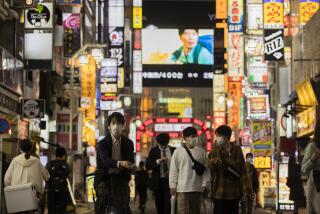THE WORLD - News from June 21, 2009
- Share via
TOKYO — A few months from now, a highly contagious disease will spread through a Japanese elementary school. The epidemic will start with several unwitting children, who will infect others as they attend classes and wander the halls.
If nothing is done, it will quickly gain momentum and race through the student body and jump to parents and others in the community. But officials will attempt to stymie the disease -- using cellphones.
The sickness will be a virtual one, a government-funded experiment. A subsidiary of Softbank Corp., a major Internet and cellular provider, has proposed a system that uses phones to limit pandemics.
The details have yet to be fixed, but Softbank hopes to pick an elementary school with about 1,000 pupils and give them phones linked to the Global Positioning System. The location of each child will be recorded every minute and stored on a central server.
A few students will be chosen to be considered “infected,” and their movements over the previous few days will be compared with those of everyone else. The stored GPS data can then be used to determine which children have crossed paths with the infected students and are at risk of having contracted the disease.
The families of exposed students will be notified by text messages, instructing them to see a doctor. In a real outbreak, that could limit new infections.
“The number of people infected by such a disease quickly doubles, triples and quadruples as it spreads. If this rate is decreased by even a small amount, it has a big effect in keeping the overall outbreak in check,” said Masato Takahashi, who works on infrastructure strategy at Softbank.
If an infected person makes about three people sick per day, he said, and each newly infected person makes three people sick, on the 10th day about 60,000 people would catch the disease. If each sick person instead infected two people a day, on the 10th day about 1,500 people would get sick.
The experiment was conceived before the swine flu outbreak, but has drawn attention now that Japan has the highest number of confirmed cases outside North America.
It is one of 24 trials the government recently approved as part of a program to promote new uses for Japan’s Internet and cellular infrastructure. The country boasts some of the most advanced cellphone technology in the world.
GPS has its shortcomings, including hazy readings indoors. But Softbank believes it could keep readings accurate to several yards, at least for an experiment in a limited area.
Until now, GPS has mainly been used to help people figure out where they are and what is nearby. As networked devices, such as the iPhone, become more popular, new applications let people track their children or friends, and could give companies and governments access to their location.
Aoyama Gakuin University, a prestigious school in Tokyo, is giving iPhone 3G to students, partially as a way to check attendance via GPS readings.
More to Read
Sign up for Essential California
The most important California stories and recommendations in your inbox every morning.
You may occasionally receive promotional content from the Los Angeles Times.













